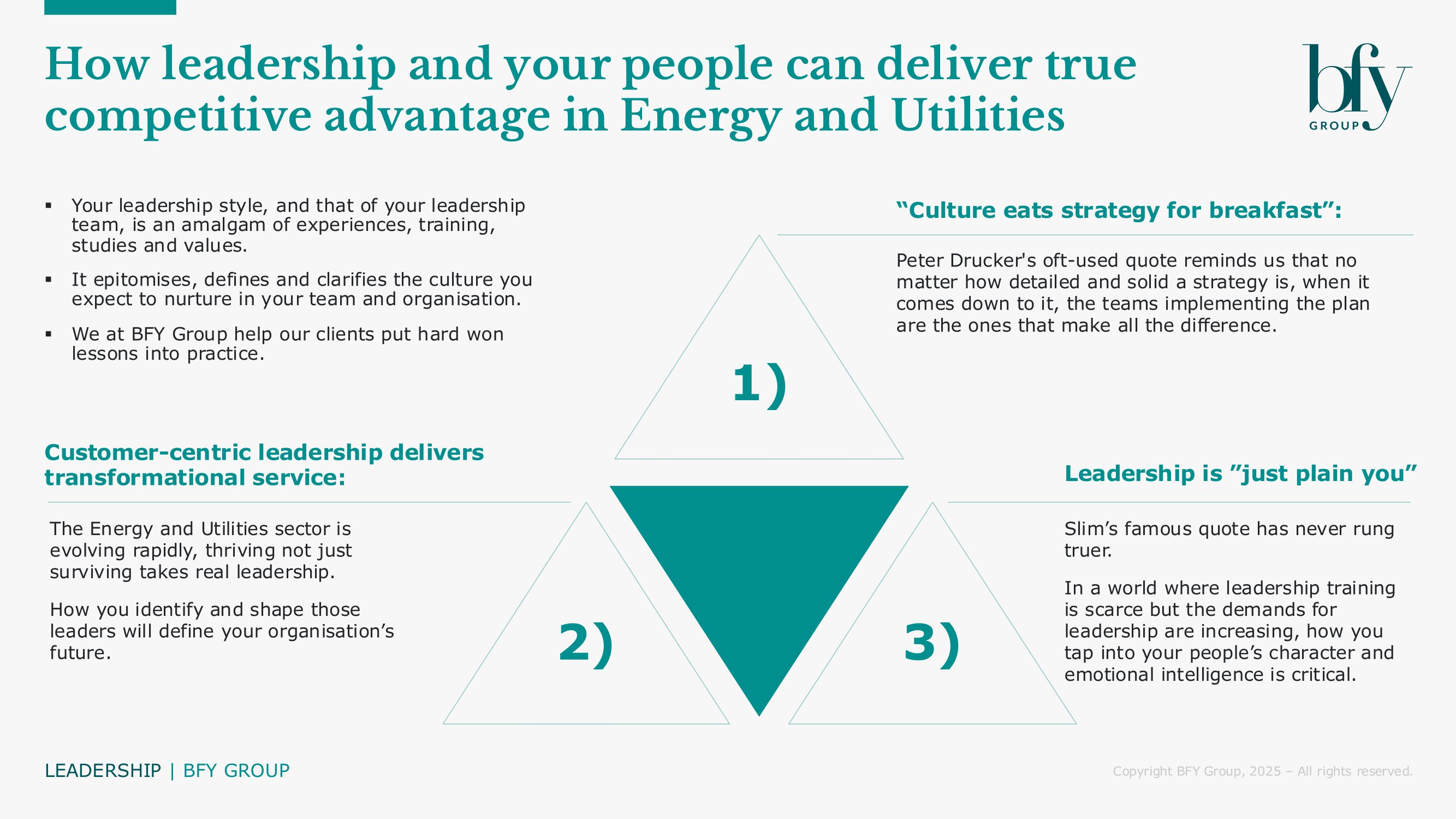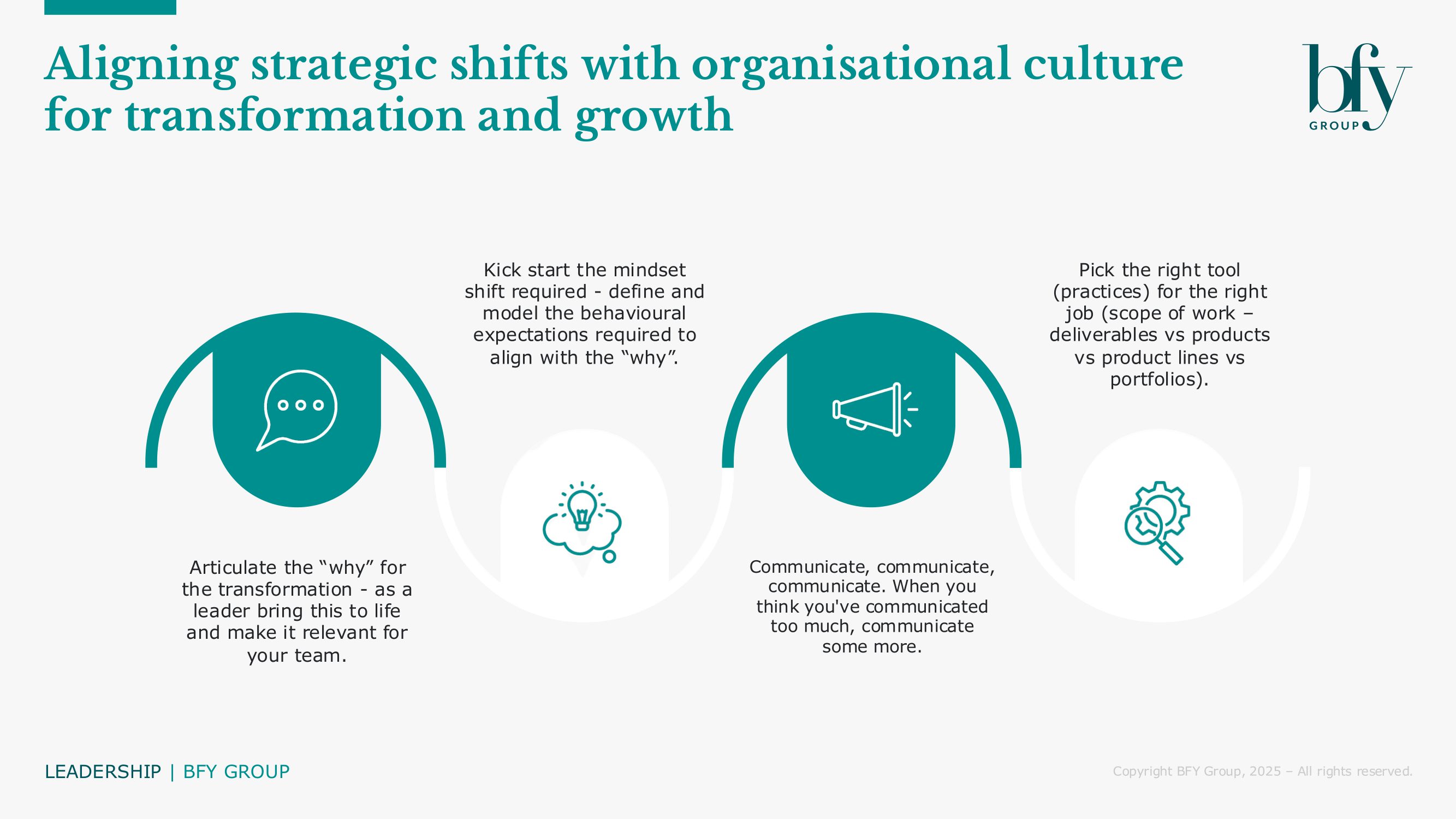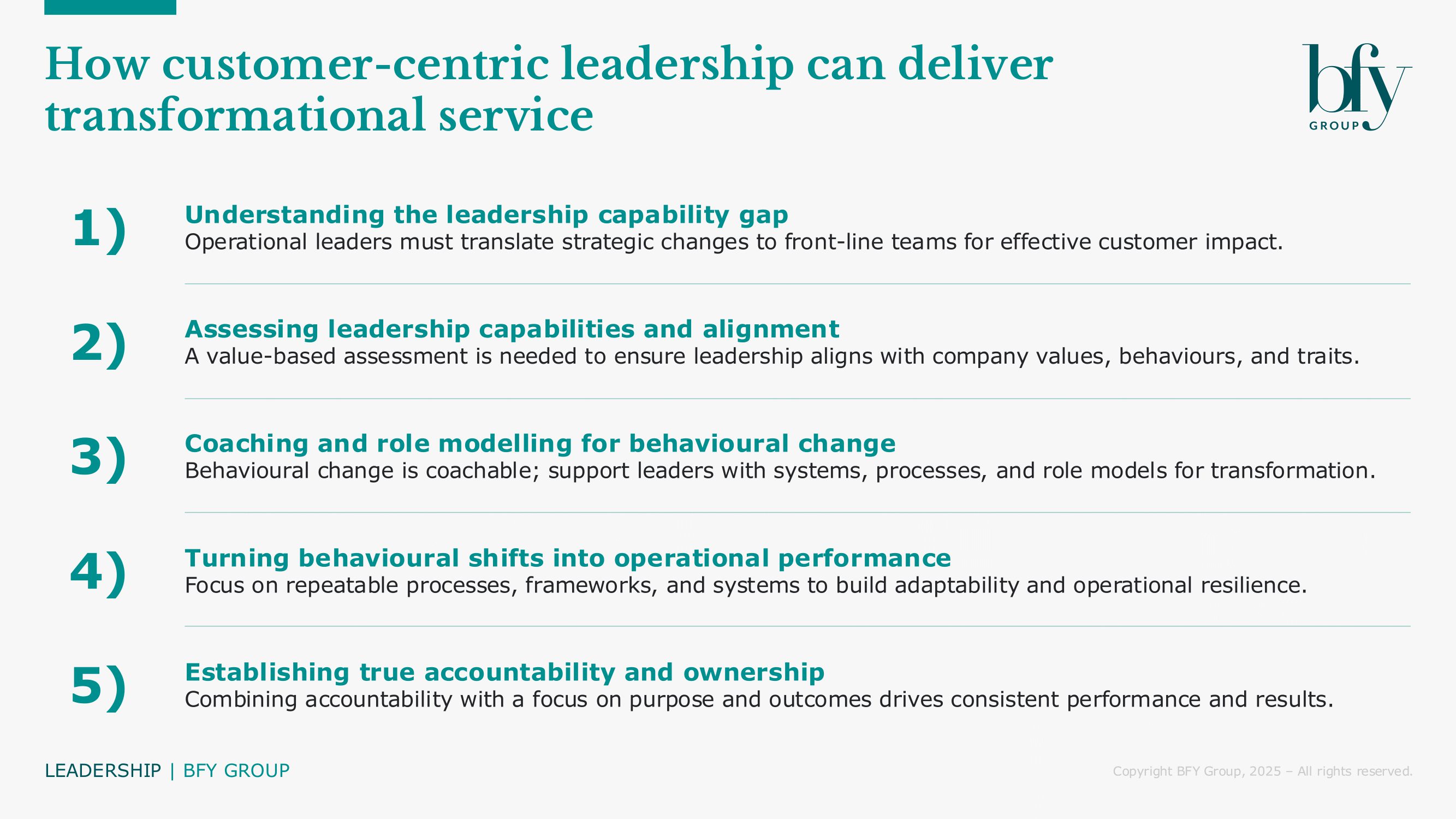Your leadership style, and that of your leadership team, is an amalgam of experiences, training, studies and values. It epitomises, defines and clarifies the culture you expect to nurture in your team and organisation.
Mine is built on three generations of military service, including almost 20 years’ personally, refined by over a decade in the cauldron that is management consulting.
I’ve studied at RMA Sandhurst, the Defence Academy, Cranfield University, and wider. I’ve practiced on military operations around the world, in team and account leadership as a consultant, and through sports and outdoor pursuits like scuba diving, rugby, and trail running. I’ve also learned from others - not least the amazing soldiers and NCOs I had the pleasure to serve, but also the incredible consultants and dedicated clients I’ve had the privilege to work with.
We at BFY Group help our clients put hard won lessons into practice:
- “Culture eats strategy for breakfast”: Peter Drucker's oft-used quote reminds us that no matter how detailed and solid a strategy is, when it comes down to it, the teams implementing the plan are the ones that make all the difference.
- Customer-centric leadership delivers transformational service: The Energy and Utilities sector is evolving rapidly, thriving not just surviving takes real leadership. How you identify and shape those leaders will define your organisation’s future.
- Leadership is “just plain you”: Slim’s famous quote has never rung truer. In a world where leadership training is scarce but the demands for leadership are increasing, how you tap into your people’s character and emotional intelligence is critical.

“Culture eats strategy for breakfast”
I have seen first-hand the culture within energy and water networks teams: the ‘drop everything, support your team in the field, keep the power on and the water flowing’ approach that demonstrates incredible culture.
However, when facing into large scale challenges (as the energy and utilities world seem to be constantly), with shifting regulatory demands, geopolitical difficulties, competition for finance and aging infrastructure (and workforce), the challenge of aligning operations and transformation initiatives with strategic direction becomes ever harder. In a previous article we’ve introduced techniques to help you avoid this ever so common pitfall in transformation delivery.
Before you set off on this journey, it’s vital to assess your organisational maturity to inform which practices should be incorporated into new rhythms and routines. One size does not fit all! Different organisations have different maturity levels in terms of behaviours, management practices, and business outcomes.
Exploring this from the outset will determine the practices needed to deliver the strategy. Shaping, communicating and ensuring it is delivered depends on your organisational culture - and the leaders that define it.
To ensure your strategic shifts (to deliver the transformations required to thrive not just survive) support your organisational culture:
- Articulate the “why” for the transformation - as a leader bring this to life and make it relevant for your team
- Kick start the mindset shift required - define and model the behavioural expectations required to align with the “why”
- Communicate, communicate, communicate. When you think you've communicated too much, communicate some more
- Pick the right tool (practices) for the right job (scope of work – deliverables vs products vs product lines vs portfolios)

Customer-centric leadership delivers transformational service
Universal in the success of navigating the challenge maelstrom is the ability for operational leaders to translate strategic changes, and land them successfully with those people closest to the customer.
In our experience, changes like this can uncover a gap in leadership capability and skill set, holding organisations back from realising the ambitions set by the executive team. We typically see this surface in transactional behaviour, a lack of understanding of purpose, and an inability to galvanise teams around the vision.
Building a high performing team starts with a deep understanding of your people. An assessment of current capabilities, behaviours and trait-based preferences for leadership is an important place to start, considering how closely your people are aligned to business values.
This value-based assessment is critical to ensuring you have the right people, and fundamental attitudes and behaviours, to show up every day and lead your teams to achieve desired business outcomes. The good news is that behavioural change is coachable. Understanding your leaders’ motivations, supported by appropriate role modelling, systems, and processes can strengthen their commitment to change, and how they lead others through it.
Translating that behavioural shift into operational performance focuses on the habits and inputs that can be repeated daily to achieve any outcomes required. In our world, the ability to fall back on repeatable processes, frameworks, and systems allows leaders to embrace uncertainty, deal with ambiguity and have the adaptability to cope with the modern daily operational environment.
Establishing true accountability and ownership is at the heart of leadership. Combining this with a focus on purpose and outcome, rather than task, will drive confidence as teams continuously demonstrate their impact on results. We’ve seen a focus on accountability and ownership translate into a significant improvement in employee engagement, driving a 170% increase within an energy supplier’s customer operation, as part of a wider Leadership Excellence programme.

Leadership is “just plain you”
In a world where 82% of leaders have never received formal training, and where customers (and colleagues) expect more human experiences than ever before, the need for emotionally intelligent leadership has never been greater.
Where everyone has access to the same smart tools (including AI agents), efficiency increasingly stops being the differentiator, creating opportunity for your people, and your leaders to become that thing that sets you apart.
As we explored in our recent UKCSI blog, emotional connection is quickly becoming a real competitive advantage. When customers interact with your brand, they remember how they felt – not just that power or water supply was restored, that bills were explained or that complaints were handled well. Your leaders are at the heart of building those emotional connections.
Great leaders shape culture. They create the environment where teams thrive, customers feel understood, and innovation happens. Yet many leaders are stuck firefighting, managing turnover, and navigating siloed teams, leaving little time and empowerment to lead. This critical leadership gap represents both a risk and an opportunity.
Psychometric tools, widely available across the energy and utilities sector, can help address this gap yet their full potential remains largely untapped. The strategic use of psychometrics can measurably elevate leadership capability, operational impact and customer experience. According to Harvard Business Review (2020), organisations using psychometric assessments dynamically have seen a 24% increase in leadership effectiveness over two years. We believe the science, using this testing at BFY Group, and putting it into practice ourselves.

The foundation of effective leadership development starts with understanding. When used strategically, these tools offer valuable insights into how individuals lead, communicate, make decisions, and respond under pressure. This data can be used to create a clear picture of dynamics across leadership teams that shape targeted development strategies.
When leaders understand themselves and each other better, they build more balanced teams, manage pressure effectively, and collaborate naturally. This drives stronger culture and better business performance across KPIs, customer experience, and long-term growth.
An example: Driving leadership capability growth
Working with a leading UK energy firm, our Leadership Excellence Programme leveraged robust psychometric assessments, tailored specifically to deliver maximum value. We saw a 43% uplift in leadership capability, built from day one leveraging these insights.
An example: Implementing LPM at scale to realise ~£10m OPEX saving
When faced with board-level challenges surrounding the correlation of operational effort with strategic objectives, our team utilised LPM in redesigning a large-scale operating model, enabling a ~£10m OPEX saving and accelerating time to market for launching new initiatives from > one year to 4 weeks..
An example: Leadership excellence drives seismic increase in NPS
Previously at a large energy supplier, we’ve helped customer operations to directly improve response quality and excel at end-to-end ownership of customer accounts by applying high performance processes, systems, and operational frameworks. This was reinforced by repeatable, habit-forming coaching and development support to execute the approach effectively, which contributed to a +34 swing in NPS.
Some questions to consider:
- How confident are you that your operational leaders are translating key objectives into clear, actionable direction for their teams?
- Do you have full visibility into how messages and objectives are being adapted to suit different operational functions
- Are you aware of how your leaders are sharing insights and driving discussions within their teams?
- Is every leader in your organisation aligned with your company’s vision and strategic goals?
- Do they have the skills and capabilities needed to effectively drive business performance?
For more on our impact with organisations in Energy and Utilities, and how our Leadership and People Excellence offering can help, contact Mark Hewett, Kev Brown or Jonathan Paton.
Mark Hewett
Director
Mark leads transformational change for UK energy and utility companies. His mission is to accelerate their journey to Net Zero, delivering on the promise of the energy transition and creating value for their customers, shareholders, and society across the energy value chain.
View Profile

